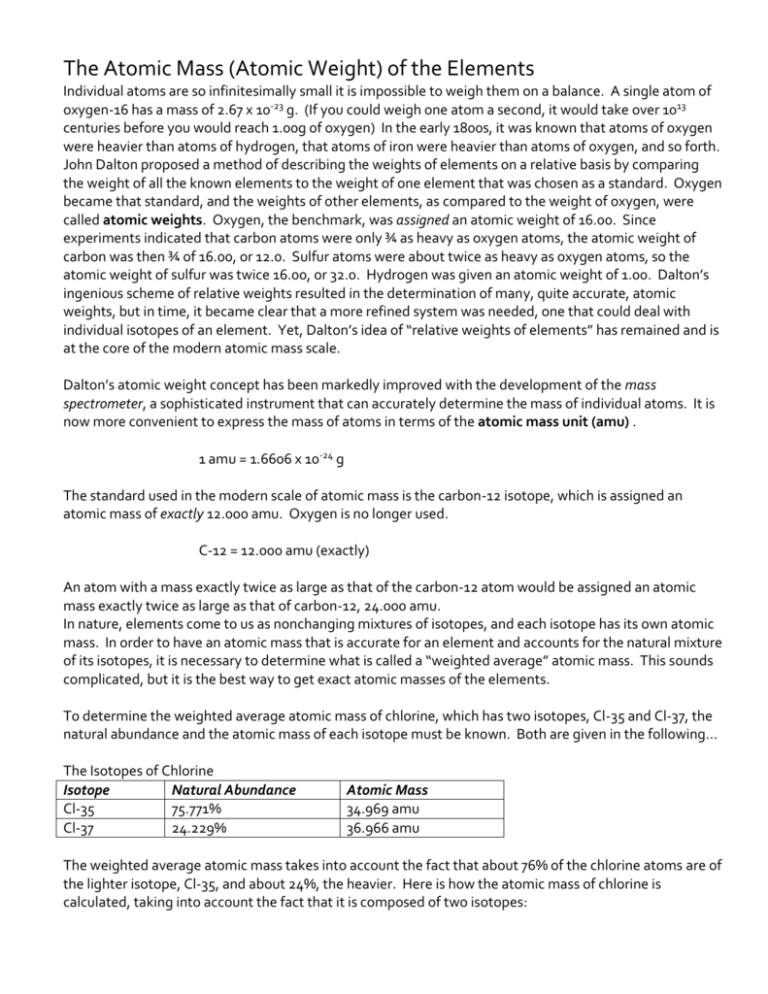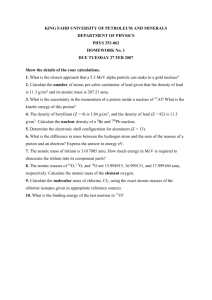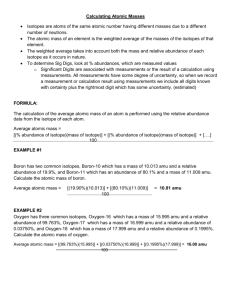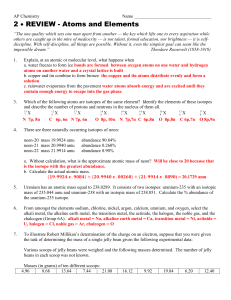File
advertisement

The Atomic Mass (Atomic Weight) of the Elements Individual atoms are so infinitesimally small it is impossible to weigh them on a balance. A single atom of oxygen-16 has a mass of 2.67 x 10-23 g. (If you could weigh one atom a second, it would take over 1013 centuries before you would reach 1.00g of oxygen) In the early 1800s, it was known that atoms of oxygen were heavier than atoms of hydrogen, that atoms of iron were heavier than atoms of oxygen, and so forth. John Dalton proposed a method of describing the weights of elements on a relative basis by comparing the weight of all the known elements to the weight of one element that was chosen as a standard. Oxygen became that standard, and the weights of other elements, as compared to the weight of oxygen, were called atomic weights. Oxygen, the benchmark, was assigned an atomic weight of 16.00. Since experiments indicated that carbon atoms were only ¾ as heavy as oxygen atoms, the atomic weight of carbon was then ¾ of 16.00, or 12.0. Sulfur atoms were about twice as heavy as oxygen atoms, so the atomic weight of sulfur was twice 16.00, or 32.0. Hydrogen was given an atomic weight of 1.00. Dalton’s ingenious scheme of relative weights resulted in the determination of many, quite accurate, atomic weights, but in time, it became clear that a more refined system was needed, one that could deal with individual isotopes of an element. Yet, Dalton’s idea of “relative weights of elements” has remained and is at the core of the modern atomic mass scale. Dalton’s atomic weight concept has been markedly improved with the development of the mass spectrometer, a sophisticated instrument that can accurately determine the mass of individual atoms. It is now more convenient to express the mass of atoms in terms of the atomic mass unit (amu) . 1 amu = 1.6606 x 10-24 g The standard used in the modern scale of atomic mass is the carbon-12 isotope, which is assigned an atomic mass of exactly 12.000 amu. Oxygen is no longer used. C-12 = 12.000 amu (exactly) An atom with a mass exactly twice as large as that of the carbon-12 atom would be assigned an atomic mass exactly twice as large as that of carbon-12, 24.000 amu. In nature, elements come to us as nonchanging mixtures of isotopes, and each isotope has its own atomic mass. In order to have an atomic mass that is accurate for an element and accounts for the natural mixture of its isotopes, it is necessary to determine what is called a “weighted average” atomic mass. This sounds complicated, but it is the best way to get exact atomic masses of the elements. To determine the weighted average atomic mass of chlorine, which has two isotopes, Cl-35 and Cl-37, the natural abundance and the atomic mass of each isotope must be known. Both are given in the following… The Isotopes of Chlorine Isotope Natural Abundance Cl-35 75.771% Cl-37 24.229% Atomic Mass 34.969 amu 36.966 amu The weighted average atomic mass takes into account the fact that about 76% of the chlorine atoms are of the lighter isotope, Cl-35, and about 24%, the heavier. Here is how the atomic mass of chlorine is calculated, taking into account the fact that it is composed of two isotopes: 1. Convert the percent natural abundance of each isotope into a decimal by dividing each by 100 (or just move the decimal two places left). 75.771% becomes 0.75771 and 24.229% becomes 0.24229 2. Multiply the atomic mass of each isotope by the decimal equivalent of its natural abundance (from #1). Cl-35 0.75771 x 34.969 amu = 26.496 amu Cl-37 0.24229 x 36.966 amu = 8.956 amu 3. The atomic mass of chlorine is the sum of the contributions from the two isotopes. atomic weight of Cl = 26.496 amu + 8.956 amu = 35.453 amu This is the “weighted average” atomic mass of chlorine that appears on the periodic table. The modern definition of atomic mass (called “atomic weight” by John Dalton) can now be stated: The atomic mass of an element is the sum of the atomic masses of its isotopes, in amu, accounting for their natural abundance, relative to the atomic mass of carbon-12. It is important not to confuse the mass number of an element with its atomic mass. Mass numbers are whole numbers that equal the number of protons + neutrons in an atom. Atomic masses compare the relative masses of atoms. Atomic masses will always be decimal numbers. The atomic mass is an extremely important property of an element and is listed along with its symbol on all periodic tables. On the other hand, the unit of atomic mass, the amu, is usually dropped in periodic tables. The unit is simply understood to be there. Practice Problems 1. Look at a periodic table. Write the atomic masses of lithium, nitrogen, and silicon. How many times heavier are silicon atoms than lithium or nitrogen atoms? 2. Knowing that 1 amu = 1.6606 x 10-24 g, what is the mass of one atom of nitrogen? 3. Element X has three isotopes. Calculate the weighted average atomic mass of element X given the following data: Isotope Abundance Atomic Mass X-85 10.00% 85.32 amu X-87 70.00% 87.51 amu X-88 20.00% 88.10 amu 4. An element occurs in nature in two isotopic forms. Use the data below to calculate the atomic mass of the element and use the periodic table and your calculated mass to determine the identity of the element. Isotope 1 has an abundance of 19.78% and an atomic mass of 10.0128 amu Isotope 2 has an abundance of 80.22% and an atomic mass of 11.0093 amu









